

Prior Episodes | 7958 (19 BBY) | Next Episodes
Continuity & Analysis
Star Wars: The Clone Wars - Old Friends Not Forgotten (2020) [S7E9]
"Outer Rim under siege! Separatist forces have launched a major offensive. Led by the evil
droid General Grievous, Republic forces are pushed to the brink. In response to this
overwhelming attack, the Jedi Council has dispatched its Generals, sending them
far from the Core Worlds to bolster the beleaguered clones. On the distant planet of
Yerbana, we find Commander Cody of the 212th in desperate need of reinforcements..."
Star Wars: The Clone Wars - The Phantom Apprentice (2020) [S7E10]
The battle for Mandalore continues, and Ahsoka finds herself face to face with Maul.
Star Wars: The Clone Wars - Shattered (2020) [S7E11]
Maul is captured and the Siege of Mandalore is won. But evil lurks elsewhere,
and the galaxy will never be the same.
Star Wars: The Clone Wars - Victory and Death (2020) [S7E12]
In the wake of Order 66, Ahsoka and Rex must work together to survive.



CONTINUITY
These four episodes form a single storyline about the Battle of Mandalore and its aftermath. The planet Yerbana
and an unidentified barren moon are seen for the first time. Three worlds are seen in these episodes:
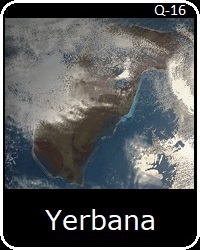


These episodes bring some of the material from the beginning of the 2016 novel Ahsoka into canon.
These four are the only episodes of the series to begin with the episode's title instead of a moral.
The last three of these episodes are the only episodes of the series to begin without a narrated newsreel.
These episodes begin with the red opening title indicating they are the end of the Maul storyarc in this series.

This storyline also takes place before, during, and after Episode III. It directly overlaps Episode III at four different points.
On the first day of this storyline, and of Episode III, the Jedi learn of the attack on Coruscant, seen in 'Old Friends Not Forgotten'.
On the second day of the storyline and film, Obi-Wan tells Ahsoka that Anakin has killed Dooku, and that he is headed to Utapau, seen
in 'The Phantom Apprentice'. - On the third day of the storyline, some members of the Jedi Council, and Aayla Secura, are meeting via
hologram, and having the same conversation about the plot Mace senses against the Jedi as is seen in Episode III, seen here in 'Shattered'.
Ahsoka enters the communications center on Mandalore just as the portions of the conversation seen in Episode III end. This is the very
day of the fall of the Jedi Order, as later in the day, Ahsoka receives echos in the Force of the attempted arrest of the Chancellor, just
before she experiences Order 66, also seen in Episode III. 'Victory and Death' is concurrent to the fourth day of Episode III,
except for the epilogue, which takes place at some time in the not too distant future.

This storyline begins immediately before Episode III. This makes it exactly concurrent to Chapters 22 to 25 of the series
Clone Wars. Anakin and Obi-Wan were therefore on Nelvaan while they are seen here to be on Yerbana. They were
also not with Ahsoka when they learned about Coruscant being under attack. This storyline is essentially compatible with
Lucas canon, except for 'Old Friends Not Forgotten', which cannot be reconciled with established events. This unfortunate
abandonment of Clone Wars continuity forces viewers to choose one series' events instead of preserving both series.
This storyline was in pre-production under Lucas, however the canon disrupting elements were probably a later addition.
- Master Depa Billaba and her Padawan Caleb Dume, are seen taking part in a meeting via hologram. They are fighting in the Battle of Kaller in the Outer
Rim, as will be seen in the episode 'Aftermath' (S1E1) of The Bad Batch. As seen in Episode III, Master Plo is fighting on Cato Neimoidia, as part of
the response to Grievous' campaigns in the Core, and Jedi Knight Aayla Secura is fighting in the unending battle on Felucia in the Outer Rim.
- Yerbana is a populated world located in the Savareen Sector of the Outer Rim, likely on the Trailing Sectors side of the Corellian Run. It is a pleasant,
terrestrial world with a green ecosystem, large oceans, and rocky and mountainous terrain. One of its cities is built on a mountain plateau and
is connected to other cities by a large suspension bridge. It is unknown which species are well-represented on this planet, but from its
architecture it is almost certainly a long-established Republic colony world.
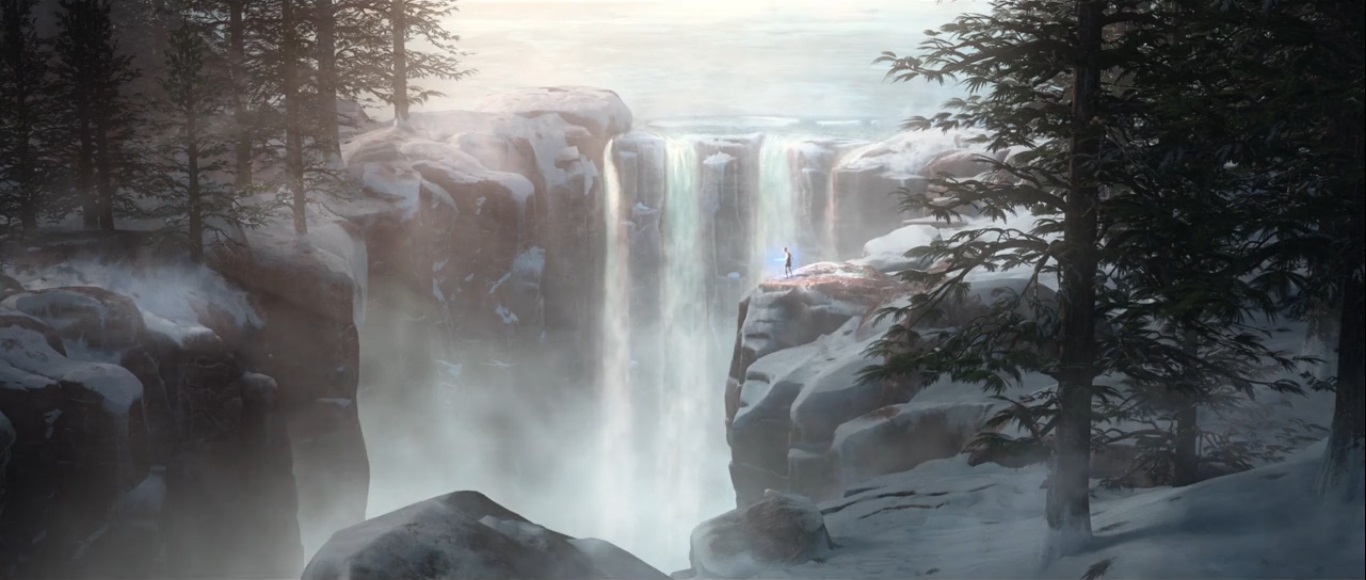

Commander Cody is wearing the insignia of a Commander, but not the higher grade insignia he is wearing in Episode III,
which is a rank called 'Marshal Commander' in supplementary material. This insignia first appeared in 'A Necessary
Bond' (S5E9), where it was either an attempt to show he was promoted in grade as Commander between then and
Episode III, or a mistake. If this was a mistake, the one red square should be second in line, rather than first, as seen
in Episode III. Whether or not the creators were being deliberate in the earlier seasons, the creators of Season 7
just kept using the same insignia, which was suspect in the last storyline, but now have run out of time. This storyline
begins on the same day as Episode III begins. It could still be explained that Cody was promoted in the couple of days
before he is seen wearing his Marshal-grade Commander insignia in that film, but that is yet again an example of
a highly unlikely explanation having to be invented to explain why the creators are so poor at continuity at times.
This possible explanation seems to have gone out the window after Cody's appearance in The Bad Batch, which
is set after Episode III, where he has once again been animated with the same insignia he is wearing here.
Main Article: Ranks and Rank Insignia
- Obi-Wan and Anakin's first adventure together in this series was on Christophsis, just over three years earlier, which is located in the same sector and
relatively close to Yerbana, which will be their last adventure together in this series. Christophsis was also when Anakin first met Ahsoka, and this
adventure will conclude with their long awaited reunion. Ahsoka's arrival on the destroyer is an inversion of her arrival on Christophsis. Ahsoka was
young, inexperienced, and excited to be Anakin's student, while Anakin didn't want her as a Padwan. Now she is matured, experienced, and not
interested in returning to the Jedi, while Anakin is eager for her to return and to be his student again.
- Anakin is at the height of his power as a Jedi, and is confident and often arrogant about it. Obi-Wan is a bit frustrated by his showy lack of concern,
as usual, and tells Ankin that he is "overdoing it, again." Anakin's point, as usual, is that the Jedi don't go far enough or are too patient with evil for
his liking, telling Obi-Wan that he "can hide here with you and we can let the people of the city suffer longer, or we can do things my way, and help
them now." He continues to find victories despite his brazen tactics, and while the Council may still be concerned about his methods, it is hard to
argue with his success. Obi-Wan also knows Anakin will do as he deems necessary whether he likes it or not, telling Anakin that he knows better
than to try and stop him. When Obi-Wan tells Bo-Katan in regard to her sister, his beloved Satine, that he cannot allow his feelings to cloud his
judgement, it draws a look of disagreement from Anakin, who has clearly chosen to prioritize his love for Padme over his Jedi path.
- Onderon has been besieged by Separatist forces, having rejoined the Republic in 'Tipping Points' (S5E5). Republic forces have been holding their
own up to this point. Anakin receives a transmission from 'Fulcrum', a code name given to Saw Gerrera, and others in the rebel network the Jedi
have set up, which Ahsoka also knew and is now using to reach Obi-Wan and Anakin directly.
- Maul was located on Mandalore by Ahsoka and Bo-Katan. He obviously became aware his location had been compromised when the Pykes reported
that a Jedi had been looking through their transmission logs only days earlier in 'Together Again' (S7E8), and used this for his plans. It is obvious that
Maul has been planning this for weeks, and thus was likely allowing Bo-Katan to track him by making predictable movements, hoping that she would
alert the Jedi to his presence. He is hiding in the capital city of Sundari, and is hoping to lure Obi-Wan and Anakin into the city. He orchestrated this
war on Mandalore, expending the planet as one of his resources, to execute this trap because he believes correctly that he is short on time due to
the rising power of the dark side. Having learned that another Jedi was sent, he draws the Republic forces into the underworld, hoping to trap
Ahsoka there and learn why she has been sent. He has Almec eliminated as an operative who has outlived his usefulness, and is now a liability as
a Republic captive, and eventually abandons his loyal Mandalorian forces to be defeated in order to cover his escape.
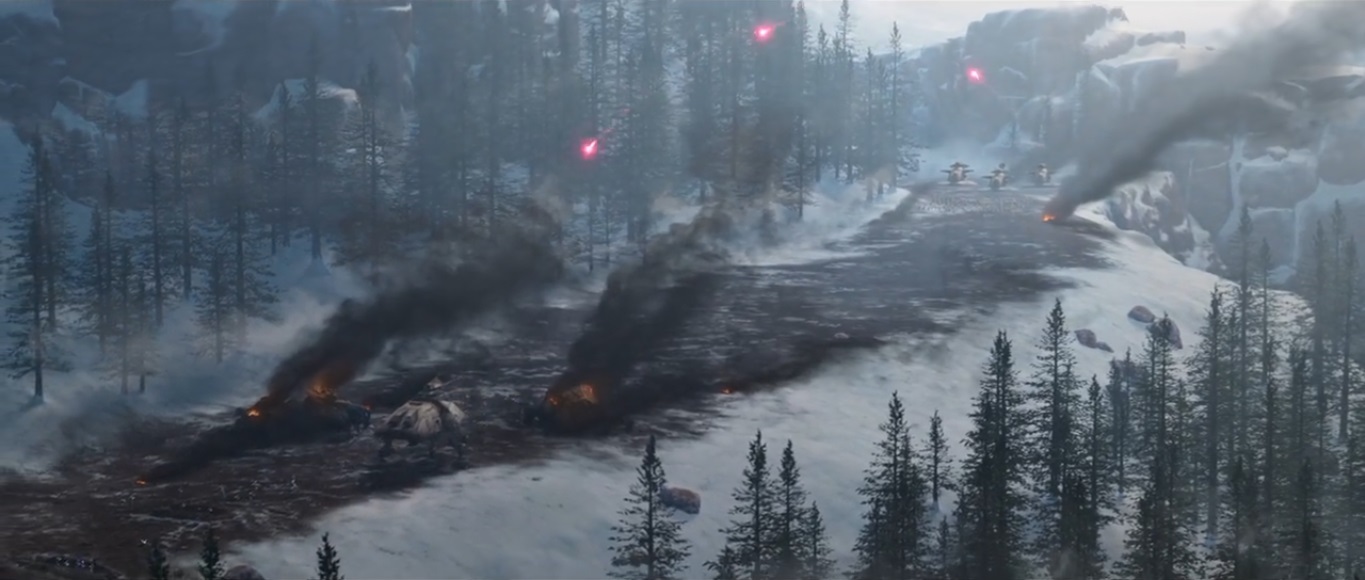
- Over one hundred years earlier, sometime before 7858 (119 BBY), treaties were signed between the Republic and Mandalore, guaranteeing that
the Republic not interfere in its internal politics and civil wars. From the implication of the conversations, it is possible that these conditions were
the means by which Mandalore became an independent part of the Republic. Based on what we have seen, the Republic is legally obligated to
respect its members' internal affairs in most instances, regardless of specific treaties, however it usually takes sides in internal conflicts.
Main Article: The Galactic Republic and the Neutral Systems
- Obi-Wan and Anakin are alerted that Grievous has launched an attack against Coruscant, and that Shaak Ti has been sent to protect the Chancellor,
but Mace has lost contact with her due to Grievous' jamming signal, as seen in the last storyline of Clone Wars chapters.

In Clone Wars 'Chapter 25', Anakin and Obi-Wan have just left Nelvaan, and are alone with R2 when Mace calls to tell
both of them that "Coruscant is under siege, and General Grievous has abducted the Supreme Chancellor. You must
return immediately. You must rescue Palpatine." Despite Dave Filoni's original assertion that The Clone Wars "won't
supersede the events and continuity" of Clone Wars, disney-era Lucasfilm created Season 7, and no longer cares about
protecting the canon of the original series. Clone Wars is Lucas canon material, and as a result this entire storyline, or
at least all portions involving Anakin and Obi-Wan, should technically be considered non-canon. The alternative is to
attempt to fit both stories into canon, which is almost possible, although it does make watching the two storylines at
the end of Clone Wars a bit confusing, and Mace's message in 'Chapter 25' would have to be completely ignored.
It was clear that this retcon was on the way after Ahsoka's statement in Rebels 'Shroud of Darkness' (S2E18), which aired
in 2016, that she last saw Anakin "rushing off to save the Chancellor." It is possible to fit in these disney-era alterations
to the story by ignoring the original intent of the creators of the Clone Wars chapters. This storyline is the only
The Clone Wars material created entirely by disney-Lucasfilm. Lucas-era canon continuity cannot be superseded or
retconned, so unfortunately this otherwise quality storyline should probably be considered to be non-canon, or at least
the first half of 'Old Friends Not Forgotten'. This storyline could have been executed without causing such disruption.
- This first episode of this storyline and the entire previous storyline from this series were intended by disney-era Lucasfilm to replace the continuity
of Clone Wars 'Chapter 22' through '25', rather than to work with it the way this series did under Lucas. While some material in those canon
chapters has been sidelined, these episodes did attempt to honor some of the spirit of those stories. In the last storyline in this series, Anakin
helped innocent people who were victims of the Techno Union, just as he did in his storyline in the chapters of the Clone Wars. In this
storyline, some features are the same as in those chapters. Anakin and Obi-Wan are fighting on Yerbana, a planet located in the same sector as
Nelvaan where they were in those chapters, and are again fighting in a siege in the Outer Rim with Cody, where Anakin solves the problem of
the battle. They are also once again in the fighter bay of their destroyer when they receive the urgent report that Coruscant is under attack.

Obi-Wan says that their fleet, located near Yerbana in the Savareen sector of the Outer Rim, can be at Coruscant within
the hour. This is far too short for canon. This is one of the longer trips one can make in the known galaxy, and although
it is a straight shot on major hyperspace lanes, if this will only take one hour, this will create a huge number of continuity
errors and issues in other material. If he had said it would take a few hours that would have made more sense, although
based on other material this trip should have taken several hours at least.
Main Article: Hyperspace Travel
- The 501st is divided into two parts, one which will accompany Anakin back to Coruscant, and the other to go with Ahsoka and Rex to Mandalore.
Appo, who was seen in Season 4 to have been a Sergeant, must have been promoted up to Captain in the interim, as he is made the Commander
of the unit which accompanies Anakin to Coruscant. Rex is made a Commander to provide the necessary seniority of rank for this operation,
since Ahsoka is acting as a non-commissioned 'advisor'. Based on the size of the 501st Legion, which is a Division-level army formation or its
relative approximate, there should have been several Captains in the unit, at least one per Battalion, so it doesn't really make sense that Rex
wasn't a Commander for most of this series, as he is always portrayed as the leader. When Rex is in violation of Order 66, Lt. Jesse tells him that
he will be demoted in rank for some reason, even though he is going to be executed, like a posthumous slap on the wrist. Apparently, treason
carries the death penalty, but doesn't carry the penalty of a dishonorable discharge.
- Anakin kept Ahsoka's lightsabers, one of which must have been recovered by him after 'The Jedi Who Knew Too Much' (S5E18), and the other recovered
from the warehouse where she was captured in 'To Catch a Jedi' (S5E19). He has replaced her green crystals with blue crystals to match his.
- Gar Saxon is the commander of Maul's Mandalorian loyalists. This is his earliest chronological appearance, but his screen debut was in the Rebels
'Imperial Supercommandos' (S3E7), when he is the Imperial Viceroy of Mandalore. He is taken prisoner in this storyline by the Republic, and
Bo-Katan is put in power by the Jedi, so it is not surprising that this one time Sith ally was freed by Sidious and installed to serve him.
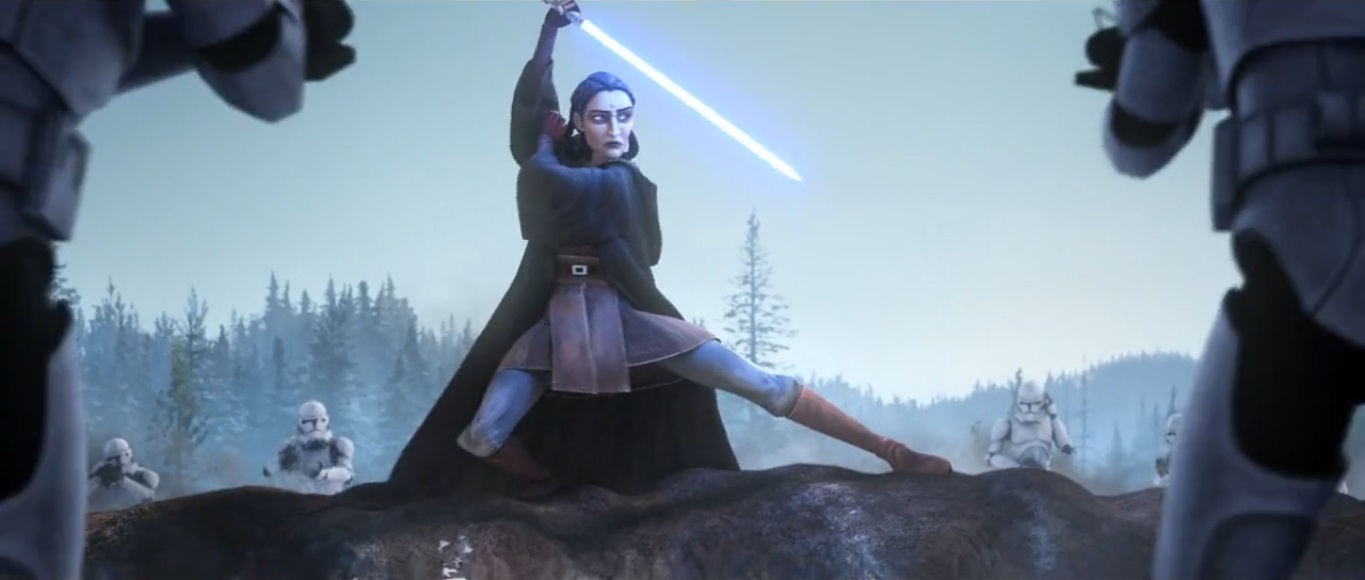

Captain Vaughn is wearing the insignia of a Commander. This insignia first appeared in 'A Necessary Bond' (S5E9), where
it was established as the insignia of a Commander. They seem to have simply used this same insignia without knowing
what rank insignia are or how they work. His insignia should have had four blue pips, rather than having a red pip at
the first position, as is the case for the Commander rank. Disney-era Lucasfilm is terrible at rank insignia continuity.
Main Article: Ranks and Rank Insignia
- As the power of the dark side grows, Sidious grows more powerful and diametrically even harder for the Jedi to see. As Sidious grows more powerful,
and the evil he and his war have wrought in the galaxy continue to grow, the power of the dark side grows. This chicken and egg circuit between
the cosmic Force and the living Force has been building in intensity over the last decade and a half parabolically. The cloud over the vision of the Jedi,
and the degree to which the Force is with those utilizing the dark side, continues to grow faster and faster. While highly dubious, it is likely that
the birth of the Chosen One is somehow connected to this, either as a response by the Force, or as a necessary co-factor.
- Maul tells Ahsoka that Sidious is "behind everything, always in the shadows," but that "very soon he will reveal himself". It is very likely that Maul means
reveal himself to the Jedi, as opposed to the galaxy, however it is an unresolved issue of canon how widely known it is that Palpatine is a Sith Lord after
the rise of the Empire, and who is aware of this and to what extent. It does not make sense that this would be publicly circulated for many reasons,
including Sith tact, popular opinion and political optics, and that Sidious' plans for the galaxy are still in progress 19 years from now in Episode IV.
Main Article: Awareness of the Jedi and the Sith
- Obi-Wan tells Ahsoka that the Council suspects that Darth Sidious is the Sith Lord who orchestrated the Clone Wars and pitted both sides against each
other. He also mentions that he first learned the name from Dooku, which was during Episode II over three and a half years earlier, although there was
great debate amongst the Council regarding whether he truly existed. Yoda's experience in 'Sacrifice' (S6E13) seems to have tipped the balance of
belief on the Council in favor of the idea that Darth Sidious is indeed the Dark Lord.
- Maul uses the mind probe to extract information from Jesse. An invasive extension of the mind trick, the mind probe is more effective on the weak-minded,
or in this case, those designed and raised to think like soldiers, and seems to come much more easily to the Sith than to the Jedi.
- Maul holds a conference with the leaders of the current members of the Shadow Collective, and orders them to go into hiding in preparation for the fall
of the Republic. They are Marg Krim of the Pyke Syndicate, Ziton Moj of the Black Sun Clan, and Dryden Vos of Crimson Dawn.

- Maul was captured by Sidious about ten or eleven months earlier in 'The Lawless' (S5E16). It is revealed that Maul's Mandalorian loyalists broke him out of
his imprisonment by Sidious and Tyranus at some point since then, and at least enough before this storyline for him to have reasserted control over his
criminal empire. Supplementary material indicates that he was held in the Spire, a high-security prison on Stygeon Prime.
- Maul tells the Mandalorian traditionalists that "it is not the way of your people to hide here in the gutters." In less than thirty years from this storyline,
Mandalorians will be lamenting that most of their surviving culture lives in sewers or other hideaways, as seen in The Mandalorian.

Maul tells Ahsoka that the Jedi "cannot defeat Sidious", but is this truly the case? It is certainly true that the Force is
with him, and the power of the dark side so strong that he is more powerful than ever. Nevertheless, Sidious is
defeated in combat by Mace, although he may have chosen not to escape as he was so confident in Anakin's fall.
It was still quite possible that Mace could have killed him, and Sidious also tried to run away from Yoda, since he
probably is unlikely to defeat Yoda on a level playing field. Certainly, if Master Plo, Master Mundi, Yoda, or a few
others has unexpectedly returned to Coruscant before Order 66, Sidious could have almost certainly been captured
or killed. Ultimately, it depends on what one means by defeat him. If the Jedi do kill the Chancellor, the state he put
in place and his allies will almost certainly still turn on the Jedi. Even if the Jedi do not become ostracized, keeping
the Republic intact, especially with the droid army still active across the galaxy, would probably be very difficult.
If Sidious felt he was in serious danger, he would have activated Order 66 anyways, so he must have risked
fighting Mace because he had seen a vision of Anakin's fall through the Force, and trusted in it. When Yoda arrives
to confront him, he has already used Order 66, which was his ace in the hole, so he could have been defeated then,
although he could still 'win' if, as he boasts, Lord Vader becomes too powerful for the surviving Jedi to defeat.
- Ahsoka doesn't tell Mace, Yoda, and Mundi what Maul told her about Anakin, probably for several reasons, but most especially because she
doesn't believe it herself, or doesn't want to believe it. This is the same reason that Obi-Wan and the Council don't believe the true things
which Dooku has been telling them on occasion for over three and a half years. They are so unwilling to believe a Sith that they don't focus
on the Senate and how the Republic is being transformed, and connect that to what Dooku told them, which could expose Palpatine.
Likewise, revealing what Maul told her to the Council could have also pointed the finger at Palpatine.

Why is Aayla Secura always seen being kept in the loop with the top members of the Council in the final two seasons
of this series? She isn't on the Council, and she isn't even a prominent Jedi Master like Luminara or Depa Billaba, who
are often privy to Council business. She is just a regular everyday Jedi Knight and General, like Anakin, who is also seen
consulting with the Council throughout the war despite his station. Ordinarily this is not noteworthy, if not for the top-
level briefing going on in this scene. Only Yoda, Mundi, and Mace are seen in the meeting, along with Aayla Secura yet
again, as seen in Episode III. Why her instead of thousands of other Jedi Knights, or likely hundreds of Jedi Masters,
or any of the other nine members of the High Council? This is likely due to her being featured in Episode III, where she
is meant to represent the many Jedi Knights who are fighting across the galaxy. Nevertheless, they had to use her in
this instance as this scene is part of a scene in Episode III, yet it is unclear why she is otherwise so often prominent.
- Maul is contained in a Mandalorian vault, sometimes called a sarcophagus, which are repulsorlift prison cells filled with various restraints and
technology designed to safely hold Force-wielders. They are a technology that date back to one of the previous eras in which the Jedi were in
conflict with the Mandalorians, and if they are old enough, the Sith as well. They were outlawed by Satine, and this is apparently the last one.
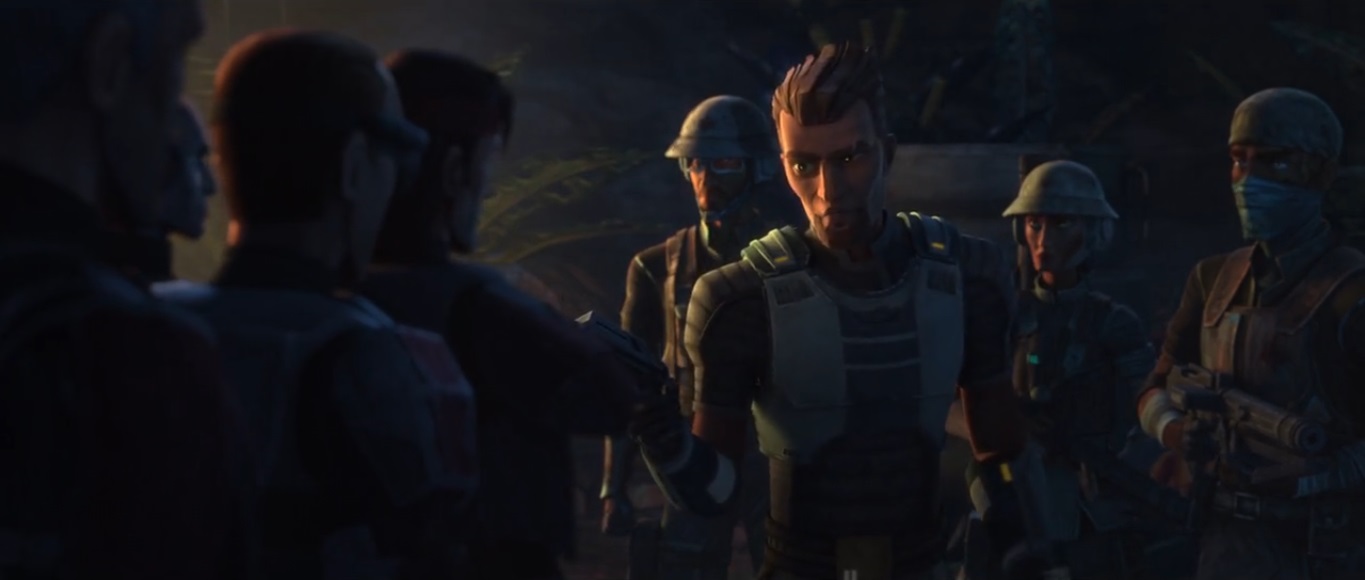
- The captain of this Republic destroyer, the Tribunal, and his executive officer are clone naval Commanders, the first examples we have seen of any
clones of this high a rank in the Navy. Their rank insignia are three red squares. Another Commander is seen in the hanger bay gantry, working next to
a clone Army Lieutenant wearing his dress uniform. Army clones have been seen wearing their dress uniforms more often towards the end of the war,
however there are plenty of earlier examples of Army clones wearing their dress uniforms when on board starships, and certainly when they are off duty.
Main Article: Ranks and Rank Insignia
- Rex receives the recorded version of the Order 66 message from Sidious in a hologram transmission, however the other clones, at least those wearing
helmets, received the go code several seconds later in a simultaneously broadcast over the speakers in their helmets. Under the protocol of Order 66,
any and all Jedi leadership must be terminated for treason against the Republic, and any trooper that does not comply with the order must be
executed for treason. The chips compel the clones to accomplished Order 66 at all costs, so all escape pods are jettisoned to prevent Ahsoka's escape.
Rex's personality and feelings are so strong, that he is able to override the programming of his inhibitor chip for several seconds before attacking Ahsoka,
enough time to mention Fives, who told Rex about this very plot and these chips in 'Orders' (S6E4), which took place eight or nine months earlier.
- In Rebels 'The Lost Commanders' (S2E3), set 15 years later, Rex mentions that he served with Ahsoka up to to the Siege of Mandalore.
This was released in 2015, long before these final episodes of this series were created. He also states that "I didn't betray my Jedi", and
that he had his chip removed. Rex absolutely betrayed Ahsoka, and she forcibly removed his chip. Of course, Rex was also an old man
remembering something from long ago at the time he said these things, and was paraphrasing for a Jedi whose trust he was trying to earn.
This is basically what Dave Filoni has suggested to explain this away, and this is sufficient explanation for this minor continuity issue if one
wants it to be, however this was not really the implication of what Rex was saying in Rebels.
- Ahsoka was outside the hull while in hyperspace for a at least a brief time. We have seen in SW continuity that people can be exposed to space for
several seconds without dying, and although she would have had to spend a few seconds cutting into the hull somewhere else, it isn't impossible
based on canon. What is notable is that there are no adverse effects to being outside while in hyperspace, at least with brief exposure. There is
certainly no air to breathe in hyperspace, and nothing to warm a person, so this would likely have killed someone without the aid of the Force
and a lightsaber to propel her and quickly slice back into the ship somewhere.

The clones who are shot at the very end of 'Shattered' are not seen lying in front of the medbay door when the scene
resumes at the beginning of 'Victory and Death', and not enough time has passed for them to have cleared them out,
not to mention that they are singly focused on executing Order 66.
- Ahsoka recites the same prayer as Chirrut Imwe in Rogue One: "I am one with the Force, and the Force is with me."
- As has always been the case in other material, the size of hyperdrive generators are directly proportional to the mass of the object they need to drive
through hyperspace at lightspeed. A large vessel like a Republic destroyer has massive hyperdrive generators, as seen here, while smaller cruisers
have what appear to be smaller versions of these, and starfighters equipped with hyperdrives must have very small generators. It is also shown here
that failure of the generators during flight leads to immediate exit from hyperspace. The disruption to the power grid also caused massive damage.
Main Article: Hyperspace Travel

Although material from this series has usually respected the vast emptiness of interstellar space, the creators did not in
this storyline. The destroyer is way too close to a planet when it is dropped out of hyperspace prematurely. It is true
that hyperspace routes, particularly the regional and local variety, do run as near to starsystems as is safe for travel,
increasing the likelihood of dropping out of hyperspace near to a star system, however what is shown here is not
correct. Hyperspace routes do not run this close to planets, the whole idea of them is that they are wide lanes that are
known to be free from obstacles, and navigational charts to avoid objects are regularly updated. When this ship drops
out of hyperspace with no ability to stop or change course, it is passing so near to a planet and its moon that it is easily
captured by the moon's gravity. Even if hyperspace routes did travel through the planetary disc of starsystems, which
they absolutely do not, if the hyperdrive were deactivated at a random point during flight, the chances of coming out
of hyperspace anywhere near this close to a planet would be so astronomical it is probably statistically impossible.
Main Article: Hyperspace Travel
- Ahsoka's destroyer crashed on an unidentified moon, probably in the Expansion Region or the Inner Rim, located near to the Hydian Way. It is rocky and
cold, and has a water cycle, as snow and ice seem prevalent. Its atmosphere is breathable, however it probably does not have a native ecosystem.
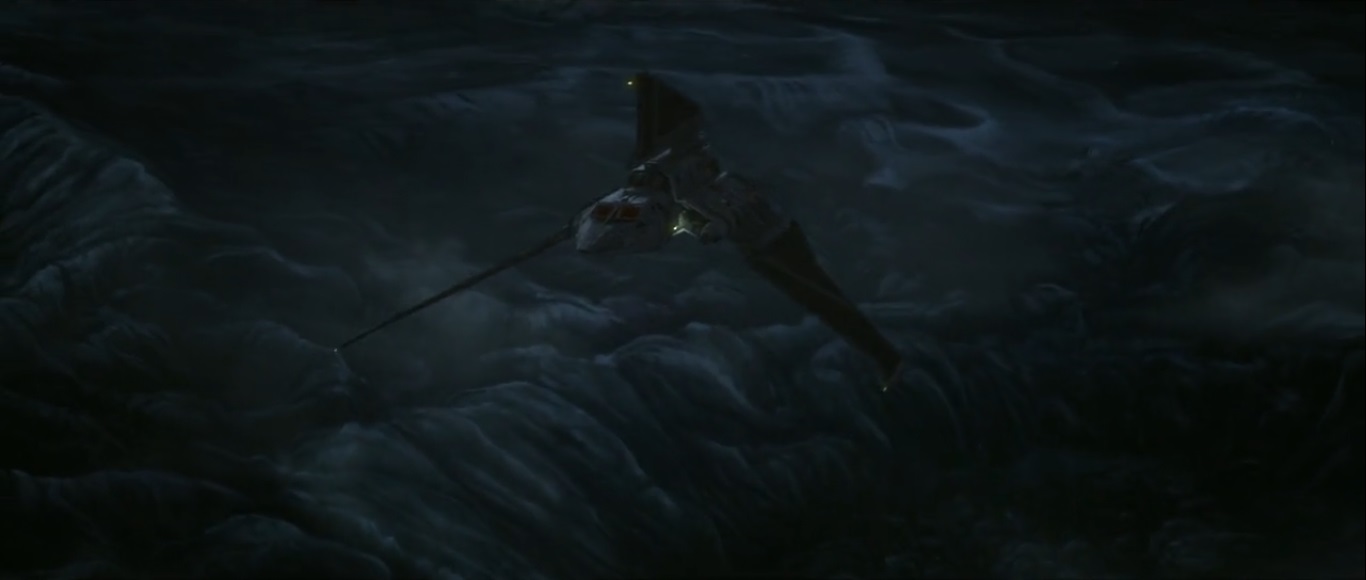
- Ahsoka and Rex bury the dead clones in graves, and grave markers are left with the clones' helmets upon them. Ahsoka drops her lightsaber, although
she is probably still holding on to her smaller secondary saber. It is obvious that this was done to honor the clones, and her dropping the saber meant
to indicate that Ahsoka intends to go into hiding. What is very unclear is if Ahsoka or Rex are concerned about the fact that this graveyard is evidence
that someone survived who didn't check in with headquarters, and obviously wasn't Maul. In the Ahsoka novel, from which these events are
loosely based, Rex's armor is placed on a different clone and buried in a grave, and false evidence of their death is provided. Ahsoka also leaves both
of her sabers in the novel, all of which would lead the Empire to at least suspect they were dead. It is not clear in this storyline if they care about being
presumed dead or not. The Empire locates the site far enough in the future that Lambda-class shuttles are in use by the military, Imperial-era Viper
probe droids are in use, and the crash and its surroundings have undergone some amount of weathering. The graveyard is mostly no longer visible,
suggesting that if the graves were located, they were probably not investigated.
- Vader locates Ahsoka's lightsaber in the snow rather easily, further evidence to suggest Force wielders have some ability to sense kyber crystals, or other
objects that are strong with the Force, particularly when they are in an area free from local distractions in the Force.
- Vader sees a convor flying overhead when he activates Ahsoka's lightsaber. A convor was the spirit animal of the Daughter, one of the Mortis gods devoted
to the light side of the Force. Since she gave Ahsoka some of her energy to restore her life in 'Altar of Mortis' (S3E16), Ahsoka is now connected to her in
the Force in some way. This planet has no apparent ecosystem, so it is unlikely this was a native convor. This was almost certainly Morai, the spirit animal
of the Daughter, or possibly the Daughter herself in an animal form, who is Ahsoka's ally and is seen near her often in the future.
- The series The Clone Wars come full circle from its premier film to its final episode. The series begins with the Jedi as noble defenders of the Republic,
ends with the Jedi wanted fugitives of the Empire with the remnants of the Republic crashed and buried on an unknown planet. The two main characters
unique to this series, Ahsoka and Rex, make fast friends in the first episode, and are optimistic about their purpose and role in the Republic in their first
adventure. Their final adventure ends with the two having only each other left as allies, with everything they worked for lost, and no purpose left.
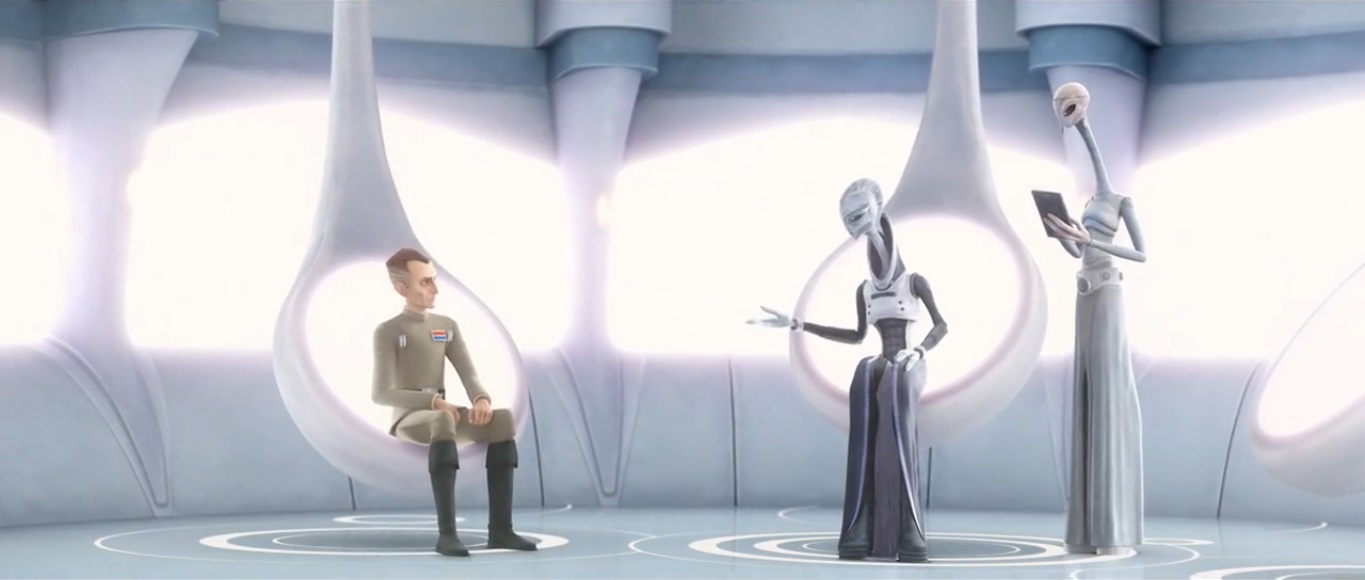
ANALYSIS
The situation in the Outer Rim has been degenerating into Republic sieges of Separatist worlds and regions for much of the last year, with the Separatists
more often on a defensive footing. Momentum of Separatist offensives have shifted heavily to the Core. In the last weeks of the war, the Separatists
launch widespread large scale offensives in the Rim, seizing or besieging countless unsuspecting Republic and neutral worlds. Republic forces, which
were already fully committed to the battles in the Rim and the Core, are taxed to their limits, and must once again distribute their Forces more thinly.
As is the desired response to this overwhelming attack, the Jedi Council has dispatches as many Jedi as possible to these new fronts, sending most far
from the Core. Yerbana is one such planet, where Separatist forces have invaded the planet and are holding the population hostage. The subsequent
Republic counterattack is led by Obi-Wan and Anakin, commanding elements of the Third Army, including Cody's 212th Attack Battalion, and Rex's
501st Legion. Republic tactics over the course of the war have been refined to focus on decapitating the enemy, as it has been found that the droid
forces are predictable and far easier to defeat without their tactical droid officers. Republic forces are still severely outnumbered in terms of ground
troops, however the clones are far superior soldiers, and this weakness of tactical command depth allows the Republic to maintain an advantage on
the battlefield. Anakin and his troops quickly route the Separatist forces in his region of the campaign, and has come to reinforce Obi-Wan and his troops,
who are pinned down trying to liberate a different city. Anakin succeeds in locating and destroying their commander, turning the tide of the battle.
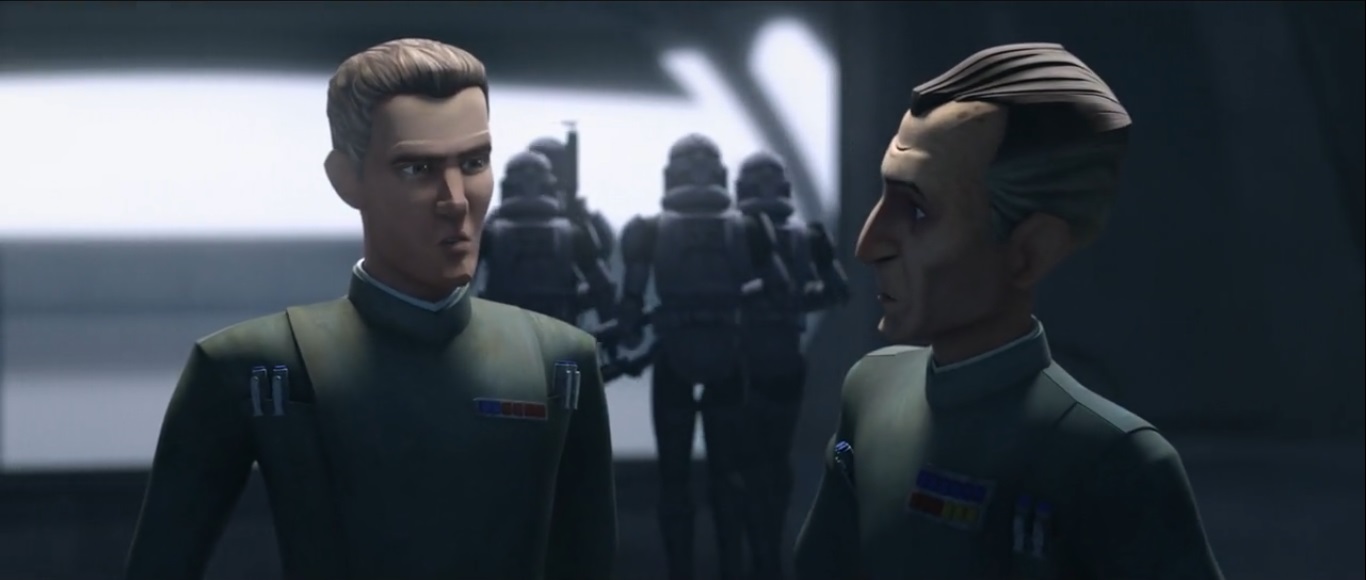
The Siege of Mandalore was a Republic invasion of a neutral planet in the Outer Rim in the very last days of the Clone Wars. Bo-Katan and her allies
sought Republic assistance for a regime change operation designed to overthrow the government of Maul's puppet Prime Minister Almec. Bo-Katan
did not believe the Jedi would assist her in assuming leadership over the planet, either because of their politics, their occupation with other wars
across the galaxy, or because of her past associations, or some combination of these factors. The Jedi agree, despite the fact that this will be in
direct violation of treaties over one hundred years old, because of the presence of a Sith Lord, the very same factor that has led to their questionable
ethics in the larger war. The Jedi are willing to support her rise to power in order to remove Maul's accomplices. Almec knows that the Republic-backed
regime will be unpopular with many, as the Mandalorian people are proud and independent. Maul's forces quickly retreat to the underworld, leaving
the Republic in a position of having to police the locals, and unable to withdraw until the battle is concluded. Bo-Katan and Mandalorian people do
not wish a Republic occupation, and the clones don't want to be acting as a police force. Despite this, occupation and police duties are soon to
become the primary post-war role for the Clones, something that would have been the case even if the Republic had not become the Empire.
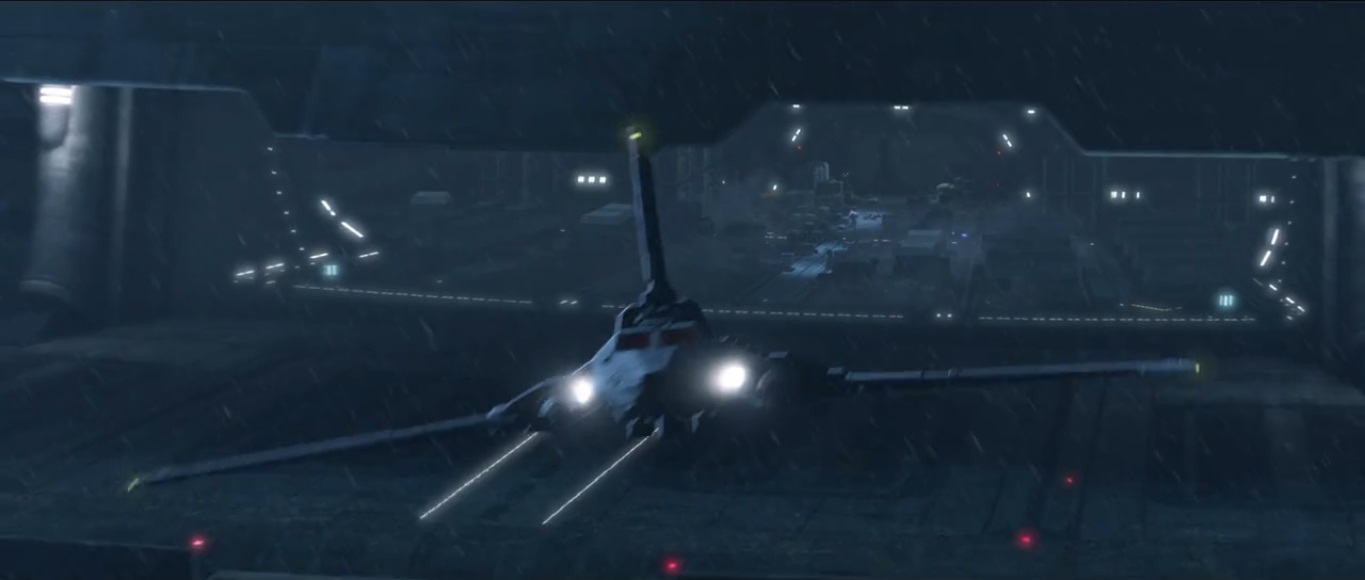
Ahsoka says that there are "people who truly need us," referring to the Jedi, and says that she had lost faith in the Order until she was reminded
of that truth. She clearly still sees herself as a Jedi, even though she is not a part of the Order. Maul compares her to himself, as they are both
former apprentices who are still Jedi and Sith, but are independent of their orders. Both are at odds with their orders because they rightly feel
betrayed by their former leaders. Ahsoka does suggest to Yoda that she is considering a future return to the Jedi, although clearly not while
the war is still going on. Ahsoka later tells Rex that as Jedi they are "trained to be keepers of the peace, not soldiers." This is of course the same
lack of nuanced understanding that many Jedi in this series seem to have. Jedi are indeed trained to be peacekeepers, but they are also trained
to be warrior knights who use violence and fight in battles to defend the innocent and defenseless from those with malicious intent. The problem
with the Order isn't that it isn't peaceful enough, it is that it is far too concerned with politics and the big picture in the galaxy. Jedi should be
out in the galaxy helping the supposedly 'unimportant' people of the galaxy rather than trying to steer galactic politics around from their ivory
tower. Ahsoka's experience is clouded by the fact that she is part of a very specific age group of Jedi who became Padwans when the war was
already in progress, and never knew what it was like to serve as a Jedi in the field in times of relative peace. Ahsoka laments that all she has
been since she was a Padawan is a soldier, which is a fair criticism, as Jedi are meant to be defenders, not offensive weapons.
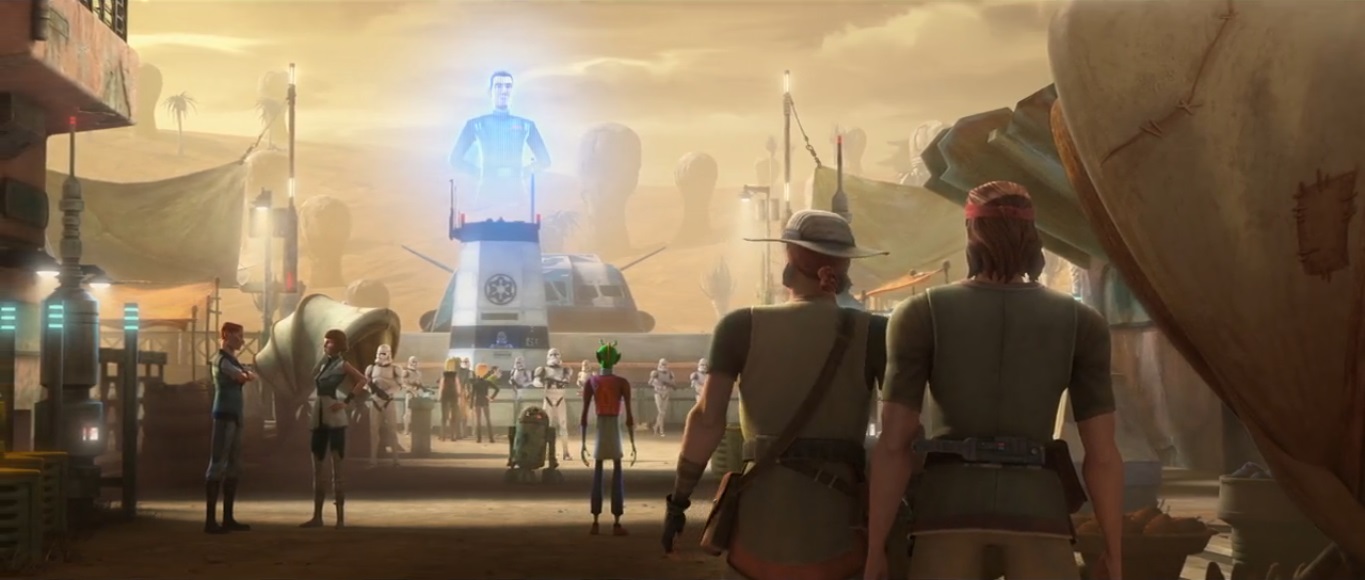
Almec tells Ahsoka that for weeks Maul "has been consumed by a strange sense of dread," which is obviously his fear of Sidious' imminent rise to
galactic ruler. Maul very much wishes to take revenge against Sidious, but is not powerful enough on his own, and will need time to train or
acquire the apprentice or allies he needs to undertake that task, something he no longer has time for before Sidious becomes even more
invulnerable. Maul had a vision in a dream about Anakin, and now has some sympathy for Dooku, who he has long hated for taking his place,
because he now sees that they were both "one step behind," temporary apprentices and weapons to be used for Sidious' plans and then
discarded once they had served their purpose. He is also aware that Anakin has "long been groomed for his role" as Sidious' new apprentice,
just as Dooku obviously was when Maul was still Sidious' apprentice. Maul also notes that the clones were bred to be excellent soldiers and
naturally combative as part of Sidious' plan, drawing another parallel to himself, as he was trained to be a warrior and an aggressive dark-sider
to be used for this plan and this war just as they were, and are equally expendable to Sidious. Maul has thus decided to lure Anakin to
Mandalore to kill him, thus "depriving Sidious of his prized pupil." Maul must kill him now, before he joins the dark side and becomes even more
powerful than he already is, since Sidious is already too powerful for Maul on his own. Maul has seen that Anakin is the "key to everything",
and that his fall to the dark side will lead to great destruction. Maul now wants to ally with Ahsoka to destroy Sidious, as he needs a powerful
and experienced apprentice, knowing that Savage's abilities were insufficient in his last attempt, even when magnified by the dark side.

As Sidious' master plan to destroy the Jedi and the Republic, what Maul calls "the only plan that matters", begins its final moves, Maul determines that
its momentum has already reached an unstoppable inertia. Maul reveals that he was never made aware of all of the details of plan, and certainly there
have been many modifications to the ways and means in the decade that Maul was living in exile. Nevertheless, Maul knows enough to understand
that the final move will be against the Jedi, and has observed enough to know the Republic has already been heavily modified to suit his plans. He also
has his vision through the Force, and he is well aware that "the dark side has never been stronger" in his lifetime. He tells his Mandalorian allies that
the galaxy will be soon remade, and that this will be the last and best opportunity to seize what power can be had before the new order fully asserts
itself. When Ahsoka tells him that Obi-Wan has bigger fish to fry than capturing him, Maul correctly suspects that "the moment may be upon us."
He reveals the existence of Darth Sidious to Ahsoka, and the fact that the Republic and the Jedi will soon no longer control the galaxy, as he is trying
to elicit Ahsoka's cooperation. He also believes that the Jedi cannot defeat Sidious, which is only true due to how effectively Sidious has stacked the deck
in his favor. Maul was clearly unaware of the programmed clones, but is impressed and delighted at the fall of the Jedi when they are activated.
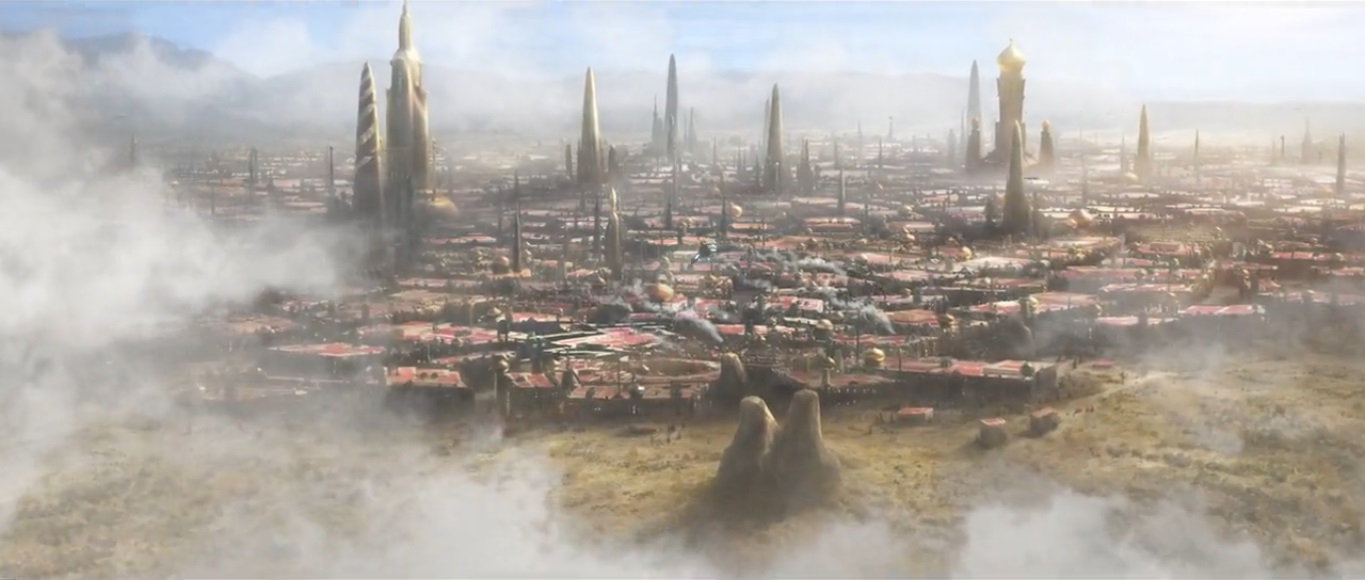
Maul tells Ahsoka that "justice is merely the construct of the current power base," an accurate analysis that emphasizes the distinction between what
is ethically right and what is just. In a perfect world, the two would be the same, something the Jedi try to aspire to in theory but often fail to realize
due to the limitations of reality, which is a big part of the reason why Ahsoka thinks the Jedi aren't good enough for her anymore. What Maul is
highlighting here is that whatever justice there was that conformed to Ahsoka's ethical beliefs within the Republic has already been co-opted by
Sidious' new order. Since justice is a social construct, and Sidious and the war have adjusted Republic society and its beliefs, the definition of justice
will soon be far from what Ahsoka considers to be right. The Republic has already fallen but the Jedi can't see it, as they clearly are still uncertain
what Palpatine plans to do with all the power he has legally accrued, and are completely unwilling to imagine that the purpose of the war was to
transform the Republic and the galactic society. As seen during Ahsoka's arrest and trial, the vital role the Jedi always played in the Republic's justice
system has already been placed under the control of the civilian government, part of the reform of every aspect of the state which Palpatine has
enacted using his expanded powers. As Maul observes, "there is no justice, no law, no order, except for the one that will replace it."
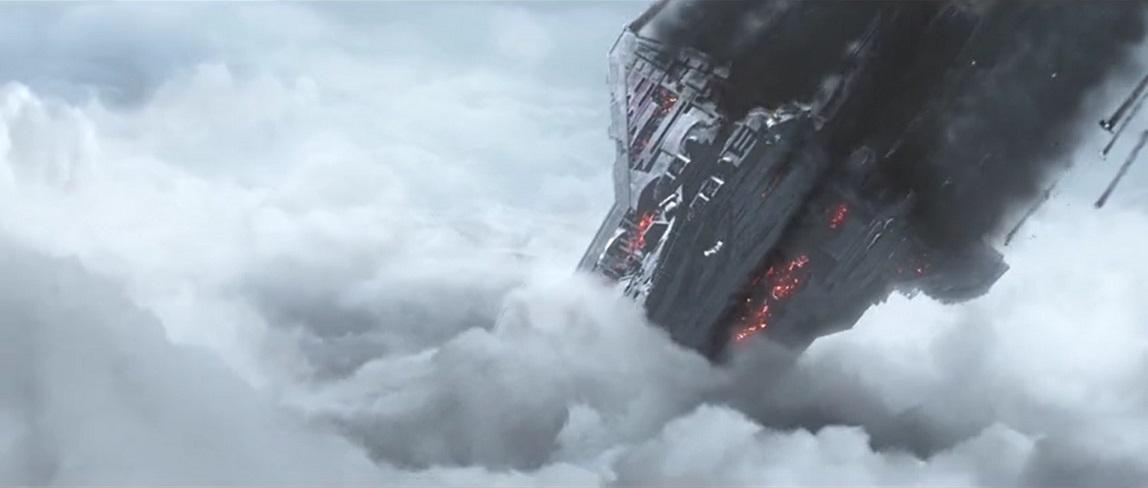
FURTHER ANALYSIS
Report Pending